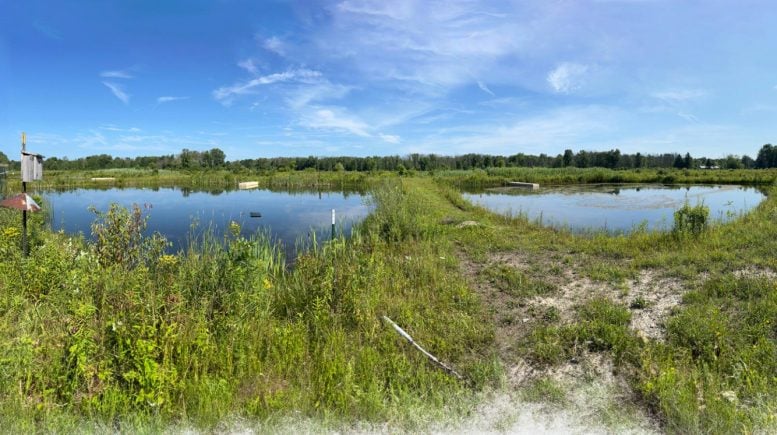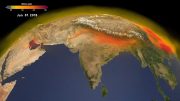
Researchers have determined that ponds, both natural and man-made, might be net emitters of greenhouse gases, specifically methane. By examining carbon burial rates and greenhouse gas emissions, the studies revealed that ponds potentially account for a significant portion of global methane emissions and capture large amounts of carbon. However, the release of methane, a gas more potent than carbon dioxide, exceeds the carbon sequestration in these ponds.
Cornell research indicates that ponds could be net emitters of greenhouse gases, particularly methane. Addressing methane release could potentially turn ponds from greenhouse gas sources to sinks.
Though human-made ponds both sequester and release greenhouse gases, when added up, they may be net emitters, according to two related studies by Cornell researchers.
The studies begin to quantify the significant effects that both human-made and natural ponds have on the global greenhouse gas budget, measurements that aren’t well understood.
“Global climate models and predictions rely on accurate accounting of greenhouse gas emissions and carbon storage,” said Meredith Holgerson, assistant professor of ecology and evolutionary biology in the College of Agriculture and Life Sciences and senior author of the studies. Nicholas Ray, a postdoctoral researcher in Holgerson’s lab, is a co-author of both papers.
Pond Impact and Carbon Burial Rates
Holgerson and colleagues have previously estimated that ponds – defined as 5 hectares (12 acres) or less and of which there could be 1 billion on Earth – may contribute 5% of the global methane emissions to the atmosphere. But without accurate measurements across many water bodies, the true number could be as little as half or as much as twice that percentage. At the same time, very few estimates of carbon burial rates in ponds exist.
One paper, “High Rates of Carbon Burial Linked to Autochthonous Production in Artificial Ponds,” published on August 18 in the journal Limnology and Oceanography Letters, examines how much carbon is sequestered in 22 Cornell Experimental Ponds. The identical ponds – there are 50 – constructed in 1964, provided highly controlled environments, with detailed records from previous studies. The data allowed Holgerson and Ray to evaluate how management activities contributed to carbon storage.

Two of 50 Cornell experimental ponds, built in 1964, and used for research. Credit: Christine Bogdanowicz
In the study, the researchers examined the past management activities, while also taking sediment cores and measurements of sediment thickness for each of the 22 study ponds. They measured the amount of carbon in the sediment, extrapolated those measurements to the overall pond, and divided that number by the age of the pond to arrive at the amount of carbon sequestered annually per square meter, a number on the same order of magnitude as wetlands and mangroves, and more than lakes.
They also found that carbon burial rates were influenced by aquatic plants (those large enough to be seen), fish, and additions of high nitrogen levels relative to phosphorus, nutrients that may not get renewed in a static pond and become limited. The right kinds and ratios of added nutrients promote plant growth, which use carbon for cells, and are deposited on the pond floor when plants die.
Carbon Sequestration and Global Impact
Although data on organic carbon sequestration in natural ponds is lacking, the scientists extrapolated their findings to estimate the total carbon burial rate in natural and artificial ponds globally. They concluded that natural and artificial ponds sequester 65% to 87% of the total amount estimated to be stored by all lakes, which indicated that scientists are globally underestimating carbon sequestration in ponds and lakes.
Seasonal Variability in Gas Emissions
The second study, “High Intra-Seasonal Variability in Greenhouse Gas Emissions From Temperate Constructed Ponds,” published on September 19 in the journal Geophysical Research Letters, examined seasonal emissions of greenhouse gases (mainly carbon dioxide and methane) from four of the Cornell Experimental Ponds.
In the study, the researchers measured gas emissions from the ponds approximately every two weeks over the course of an ice-free period in 2021.
“Global estimates of greenhouse gas budgets from ponds are highly uncertain, in part due to lack of temporal measurements,” said Ray, who is lead author of the study. The researchers found that methane – a greenhouse gas 25 times more potent than carbon dioxide – accounted for most of the gas emitted annually, and carbon dioxide and methane emissions varied greatly by season.
Ponds absorbed carbon dioxide during the early summer months when plants were growing, and emitted it later in the year, when plants decomposed. Methane was emitted throughout warm months, but week-to-week shifts in emissions were high, pointing to the need for frequent sampling for accurate accounting.
The researchers found that when water was stratified (a layer of warm water sitting on top of cold bottom waters), methane built up and led to overall higher emissions than when water was mixed by wind or sudden cooling. That’s because micro-organisms on the pond bed that produce methane require low-oxygen conditions that is disrupted by mixing.
Potential Solutions and Funding
When the results from the two papers are considered together, ponds are net emitters of greenhouse gases, due to methane release overwhelming the amount of carbon stored in the sediments. But the findings also offer the possibility of reducing methane emissions with bubblers or underwater circulators.
“If we could reduce that methane number, we could potentially flip these ponds from being net emitters to net sinks, but we have to get a handle on that methane,” Holgerson said.
References:
“High rates of carbon burial linked to autochthonous production in artificial ponds” by Meredith A. Holgerson, Nicholas E. Ray and Chelsea Russ, 18 August 2023, Limnology and Oceanography Letters.
DOI: 10.1002/lol2.10351
“High Intra-Seasonal Variability in Greenhouse Gas Emissions From Temperate Constructed Ponds” by Nicholas E. Ray and Meredith A. Holgerson, 18 September 2023, Geophysical Research Letters.
DOI: 10.1029/2023GL104235
The research was funded by the New York State Water Resources Institute.









“The researchers found that methane – a greenhouse gas 25 times more potent than carbon dioxide – accounted for most of the gas emitted annually, …”
The authors neglect to acknowledge that the methane Global Warming Potential (25X) is for an equal weight of the two gases. On a molecule-by-molecule basis, which is how it is typically measured and reported, the long-term equivalence is less than 12X because methane has a molecular weight less than carbon dioxide.
https://wattsupwiththat.com/2023/03/06/the-misguided-crusade-to-reduce-anthropogenic-methane-emissions/